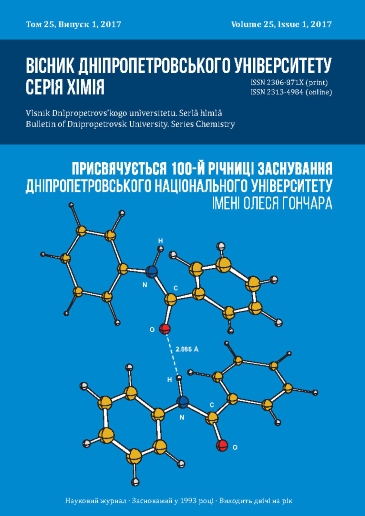The electrochemical oxidation of salicylic acid and its derivatives on modified PbO<sub>2</sub>-electrodes
DOI:
https://doi.org/10.15421/081706Keywords:
lead(IV) oxide, methanesulfonate electrolyte, electrochemical oxidation, salicylic acidAbstract
The results of the study of electrochemical oxidation of salicylic acid on PbO2-based anodes for effective wastewater treatment from organic pollutants have been summarized. Both the influence of various factors on the decomposition rate of organic substances and the influence of various modifying additives of lead dioxide anode on the process of mineralization of salicylic acid have been established. The total probable sequence of reactions to salicylic acid mineralization has been proposed. It is established that the destruction of salicylic acid in the first stage occurs through the accumulation of aromatic hydroxylation products, and during the total destruction - the destruction of the aromatic system with the formation of aliphatic compounds takes place. It is shown that the use of PbO2, deposited from methanesulfonate electrolytes and modified electrodes significantly reduces the conversion time of salicylic acid in aliphatic products compared to lead dioxide anodes obtained by traditional technology from nitrate bath. The highest degradation rate occurs at the anodes modified by bismuth. It was found that the destruction of the 5-aminosalicylic acid occurs through an intermediate oxidation of amino-group to hydroxy.References
Oturan, M. A., Aaron, J.-J. (2014). Advanced oxidation processes in water/wastewater treatment: principles and applications. A review. Crit. Rev. Env. Sci. Tech., 44, 2577–2641. doi: http://dx.doi.org/10.1080/10643389.2013.829765 CrossRef
Chaplin, B.P. (2014). Critical review of electrochemical advanced oxidation processes for water treatment applications. Environ. Sci.: Processes Impacts., 16, 1182–1203. doi: http://dx.doi.org/10.1039/C4EM90018A CrossRef
Vargas, R., Borras, C., Mendez, D., Mostany, J., Scharifker, B. R. (2016). Electrochemical oxygen transfer reactions: electrode materials, surface processes, kinetic models, linear free energy correlations, and perspectives. A review. J. Solid State Electrochem., 20, 875–893. doi: https://doi.org/10.1007/s10008-015-2984-7 CrossRef
Brillas, E., Martinez-Huitle, C. A. (2015). Decont-amination of wastewaters containing synthetic organic dyes by electrochemical methods. An updated review. Appl. Catal., B, 166–167, 603–643. doi: https://doi.org/10.1016/j.apcatb.2014.11.016 CrossRef
Martinez-Huitle, C. A., Brillas, E. (2009). Decont-amination of wastewaters containing synthetic oranic dyes by electrochemical methods: a general review. Appl. Catal., B, 87, 105–145. doi: https://doi.org/10.1016/j.apcatb.2008.09.017 CrossRef
Oturan, M. A., Pimentel, M., Oturan N., Sires, I. (2008). Reaction sequence for the mineralization of the short-chain carboxylic acids usually formed upon cleavage of aromatics during electrochemical fenton treatment. Electrochim. Acta, 54, 173–182. doi: https://doi.org/10.1016/j.electacta.2008.08.012 CrossRef
Pera-Titus, M. Garcıa-Molina, V., Baсos, M. A., Gimenez, J., Esplugas, S. (2011). Degradation of chlorophenols by means of advanced oxidation processes: a general review. Appl. Catal., B, 47, 219–256. doi: https://doi.org/10.1016/j.apcatb.2003.09.010 CrossRef
Enache, T. A., Oliveira-Brett, A. M. (2011). Phenol and para-substituted phenols electrochemical oxidation pathways. J. Electroanal. Chem., 655, 9–16. doi: https://doi.org/10.1016/j.jelechem.2011.02.022 CrossRef
Dhaouadi, A., Adhoum, N. (2009). Degradation of paraquat herbicide by electrochemical advanced oxidation methods. J. Electroanal. Chem., 637, 33–42. doi: https://doi.org/10.1016/j.jelechem.2009.09.027 CrossRef
Antonopoulou, M., Evgenidou, E., Lambropoulou, D., Konstantinou, I. (2014). A review on advanced oxidation processes for the removal of taste and odor compounds from aqueous media. Water Res., 53, 215–234. doi: https://doi.org/10.1016/j.watres.2014.01.028 CrossRef
Cattarin, S., Musiani, M. (2007). Electrosynthesis of nancompo-site materials for electrocatalysis. Electrochim. Acta, 52, 2796–2805. doi: https://doi.org/10.1016/j.electacta.2006.07.035 CrossRef
Tian, M., Adams, B., Wen, J., Asmussen, R. M., Chen, A. (2009). Photoelectrochemical oxidation of salicylic acid and salicylaldehyde on titanium dioxide nanotube arrays. Electrochim. Acta, 54, 3799–3805. doi: https://doi.org/10.1016/j.electacta.2009.01.077 CrossRef
Ai, S., Wang Q., Li, H., Jin, L. (2005). Study on production of free hydroxyl radical and its reaction with salicylic acid at lead dioxide electrode. J. Electroanal. Chem., 578, 223–229. doi: https://doi.org/10.1016/j.jelechem.2005.01.002 CrossRef
Marselli, B., Garcia-Gomez, J., Michaud, P.-A., Rodrigo, M. A., Comninellis Ch. (2003). Electrogeneration of hydroxyl radicals on boron-doped diamond electrodes. J. Electrochem. Soc., 150, D79-D83. doi: http://dx.doi.org/10.1149/1.1553790 CrossRef
Guinea, E., Arias, C., Cabot, P. L., Garrido, J. A., Rodriguez, R. M., Centellas, F., Brillas, E. (2008). Mineralization of salicylic acid in acidic aqueous medium by electrochemical advanced oxidation processes using platinum and boron-doped diamond as anode and cathodically generated hydrogen peroxide. Wat. Res., 42, 499-511. doi: https://doi.org/10.1016/j.watres.2007.07.046 CrossRef
Shmychkova, O., Luk'yanenko, T., Amadelli, R., Velichenko, A. (2016). Electrodeposition of Ni2+-doped PbO2 and physicochemical properties of the coating. J. Electroanal. Chem., 774, 88–94. doi: https://doi.org/10.1016/j.jelechem.2016.05.017 CrossRef
STOE WinXPOW, version 3.03. (2010). Darmstadt: Stoe & Cie GmbH.
Kraus, W., Nolze, G. (2000). PowderCell for Windows (version 2.4) Berlin: Federal Institute for Materials Research and Testing.
Rodriguez-Carvajal, J. (2001). Recent developments of the program FULLPROF, Commission on Powder Diffraction (IUCr). Newsletter, 26, 12-19.
Shriner, R. L., Hermann, C. K. F., Morrill, T. C., Curtin, D. Y., Fuson, R. C. (2004). The systematic identification of organic compounds. 8th Edition, Hoboken, NJ: John Wiley & Sons, Inc. doi: https://doi.org/10.1021/np058223w CrossRef
Velichenko, A., Luk’yanenko, T., Nikolenko, N., Amadelli, R., Danilov, F. (2007). Nafion effect on the lead dioxide electrodeposition kinetics. Russ. J. Electrochem., 43, 118-120. doi: https://doi.org/10.1134/S102319350701017X CrossRef
Shmychkova, O., Luk'yanenko, T., Yakubenko, A., Amadelli, R. Velichenko, A. (2015). Electrooxidation of some phenolic compounds at Bi-doped PbO2. Appl. Catal., B, 162, 346–351. doi: https://doi.org/10.1016/j.apcatb.2014.07.011 CrossRef
Downloads
Published
Issue
Section
License
Copyright (c) 2017 Oles Honchar Dnipropetrovsk National University

This work is licensed under a Creative Commons Attribution 4.0 International License.
- Authors reserve the right of attribution for the submitted manuscript, while transferring to the Journal the right to publish the article under the Creative Commons Attribution License. This license allows free distribution of the published work under the condition of proper attribution of the original authors and the initial publication source (i.e. the Journal)
- Authors have the right to enter into separate agreements for additional non-exclusive distribution of the work in the form it was published in the Journal (such as publishing the article on the institutional website or as a part of a monograph), provided the original publication in this Journal is properly referenced
- The Journal allows and encourages online publication of the manuscripts (such as on personal web pages), even when such a manuscript is still under editorial consideration, since it allows for a productive scientific discussion and better citation dynamics (see The Effect of Open Access).


